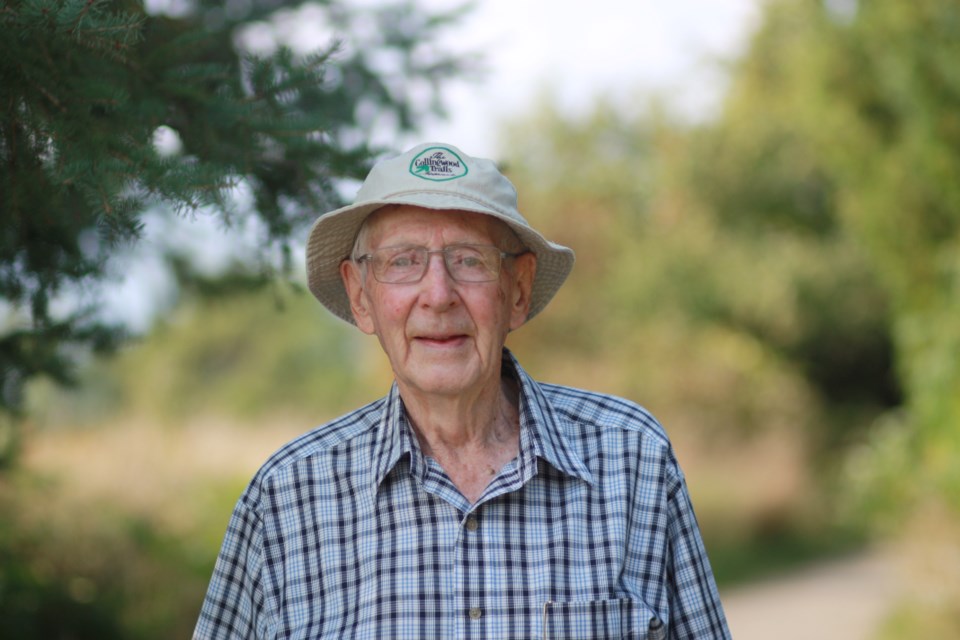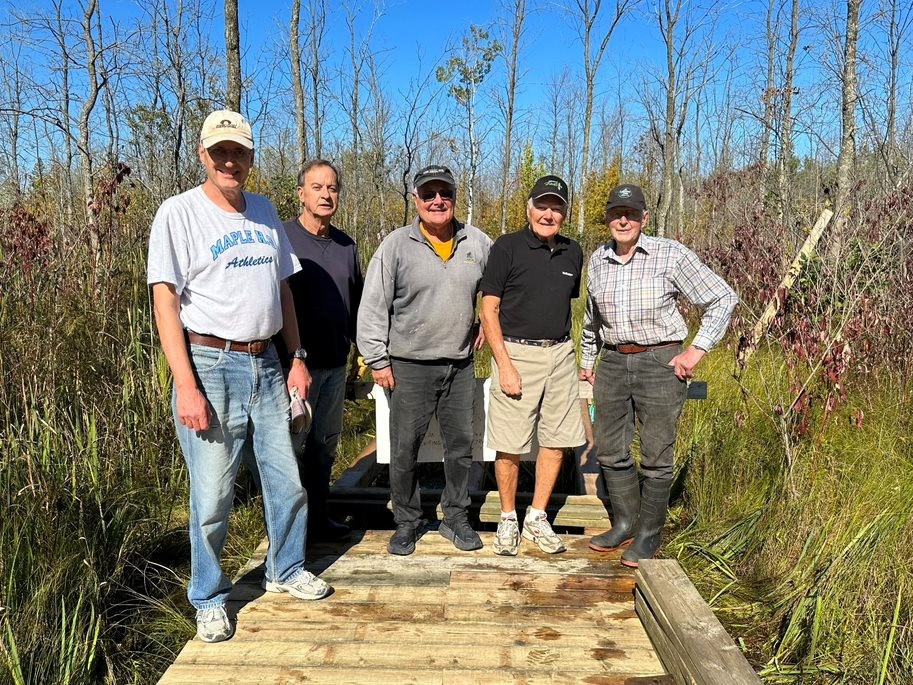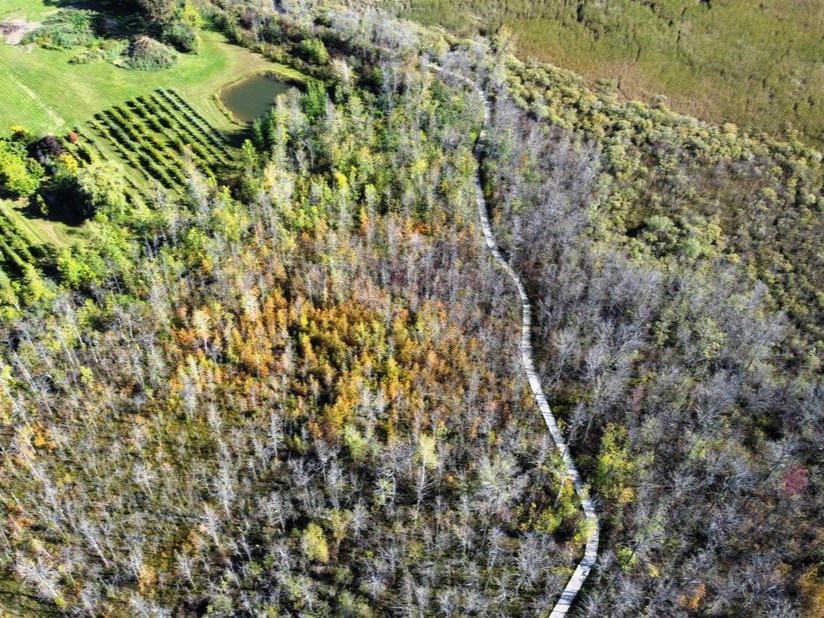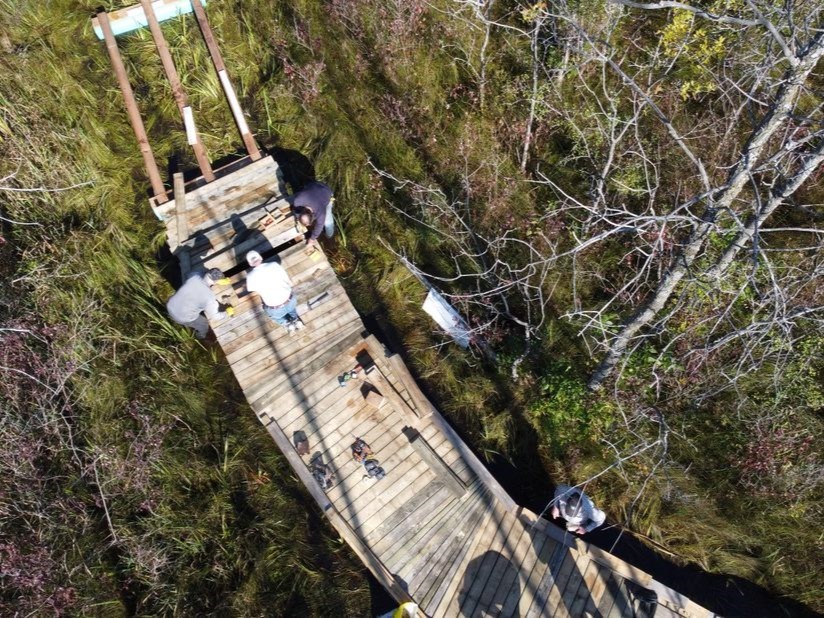Each plank of the under-construction Cranberry Marsh Trail boardwalk has been repurposed from old decks, former docks at the Collingwood harbour, and construction projects around town, the boardwalk itself is a testament to Collingwood’s community and history.
Spearheaded by local retiree George Christie, alongside his team of trail-enthusiast volunteers that include Jack Marley, Wayne Caswell and Dave Stamper, the group has worked meticulously, plank-by-plank, to build a boardwalk worthy of the beauty that exists in the Cranberry Marsh.
In an interview with CollingwoodToday, Collingwood’s ‘Mr. Trails’ spoke about why he feels building the boardwalk is so important.
“(It’s important) so people can see the marsh and get an idea of how big it is,” said Christie.”It has grown each year.”
“The number of people that come out...they’re so pleased to be out in the middle of nowhere,” he mused.

Christie was born and raised in Collingwood, but moved away for a career as a stock broker. Upon his retirement in the 1990s, he moved back to town, and was dismayed to find there was no way for him to take his snowmobile from Collingwood up to the Blue Mountains as the trails system in Collingwood was disjointed and missing many connections.
“Looking at a trail map was like looking at worms on a plate,” he said. “That’s what started it all.”
This began Christie’s foray into his extensive volunteer career, in which he has worked to connect, expand, and improve Collingwood’s trails over the past 30 years. In recognition of his tireless work, the town named the George Christie Nature Trails in his honour. He also still sits as an honorary member of the town’s Trails and Active Transportation Committee after he maxed out on the number of allowable terms.
Christie says the idea for the Cranberry Marsh boardwalk first came to him in 2003 when walking in the marsh with Michelle Rich. He recalls, that day, the duo came to a particularly muddy area.
“There was a deer path along the edge of the marsh. Michelle was one of our main characters on the trails committee of the time,” recalled Christie. “We came to one spot that was a little bit mushy.”
“She stepped on it and went down up to her knee. She came up without her shoe,” he said.
At that time, Christie says he salvaged some wood from Pretty River Academy to fix that spot.
“That’s still there today,” he said.
His attention then focused on the marsh, Christie says he noticed the water would rise upon occasion when he and other volunteers would go out to cut grass. Boardwalk construction really started in 2016, with the help of his volunteer army.

“It got to a point where we thought the boardwalk we put in was pretty good. Why don’t we extend it?” said Christie.
The boardwalk reached the turn off to Pretty River Academy by the fall of 2017.
In 2021, an observation platform that had fallen into disrepair was rebuilt as part of the boardwalk, overlooking the marsh. At that time, the existing trail was extended by about 100 feet to meet up with the platform.
Early on in construction, when the Collingwood Yacht Club did renovations to the docks at the Collingwood harbour, they donated wood from the old docks to keep the project going. Planks taken out of the Harbourview boardwalk when it was rebuilt were repurposed for the cause. Old decking from the Collingwood Ski Club and homes along Mariner’s Haven have also made their way into the boardwalk.
People around town, hearing of the project, have called Christie up when they’re replacing their personal decks, and Christie will spring to action with his group of volunteers to attend homes around town and remove the wood in six-foot intervals.
“We salvaged what we could from wherever we could,” said Christie. “It was perfectly good wood. Some of the wood that’s in there now has been there since 2003, and it’s still as strong as the day it was laid down.”
Christie emphasizes the work of his volunteer team in getting the project to this point.
“I get on my computer and say ‘We’re going to be doing work on Friday,’ and I send it out. They all reply. Enough people show up,” said Christie.
The ownership of the marsh has changed hands over the years, with the town being the current owner. The town contributes planks of six-by-six treated beams that make up the base of the boardwalk, while the planks that make up the top of the boardwalk were donated.
“Wendy (Martin, the town’s manager of parks) has given me anything I ask for. I have to be careful what I ask for,” said Christie, with a laugh.

This year, the length of the boardwalk hit 500 metres. Christie says there is one more section of 12-foot lengths to go this year before volunteers pack it in for the winter. But they’ll be back after the thaw in 2024, with 10 more sections to go to get to a junction point. At that junction, the boardwalk will expand to become 10-feet wide at Highway 26 beside Greentree Gardens.
The boardwalk will eventually end about 100 metres behind the Georgian Bay Hotel and connect with the Georgian Trail.
“That’s the dream,” he said. “It’s all in my head. We’re dreaming that this is the route that will actually occur.”
Christie says a timeline to completion for the boardwalk is hard to nail down, as it will depend on factors such as development progress in the area, how many lumber donations they receive, and how fast the volunteers can work. He says anyone who has wood they can contribute to the project or would like to volunteer is welcome to email him at [email protected].
“We’re waiting for more people to do it,” he said.
The Cranberry Marsh Trail is located at the west end of Collingwood across the highway from Lighthouse Point and just east of the Georgian Bay Hotel. You can get there via the Cranberry Inn Trail, or from the Georgian Trail via Atoka Trail and Cranberry Trail West.
For a map of all of Collingwood’s trails, click here.
With files from Erika Engel.
